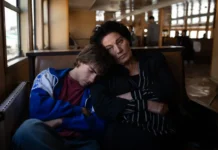The Golden Age of Hollywood
Step into the glitz and glamour of Hollywood’s Golden Age, a pivotal era in the history of cinema that continues to captivate audiences worldwide. Spanning from the late 1920s to the early 1960s, this period saw the rise of iconic stars, groundbreaking films, and the establishment of the studio system.

The Golden Age represents a time when the silver screen brought larger-than-life stories and unforgettable characters to the forefront of popular culture, leaving an indelible mark on the entertainment industry. From the enchanting allure of black-and-white classics to the emergence of Technicolor spectacles, this era defined the essence of timeless elegance and sophistication.
Join us on a journey through the glittering landscape of vintage Hollywood, where larger-than-life personalities, legendary directors, and timeless classics converged to shape the very essence of cinematic storytelling.
The Pioneers of the Golden Era
As we delve into the annals of Hollywood’s Golden Era, it’s impossible to overlook the pioneering actors who graced the screen with their charismatic performances and left an indelible mark on the industry.

The likes of Clark Gable, Marilyn Monroe, Humphrey Bogart, Ingrid Bergman, and Audrey Hepburn epitomized the epitome of stardom, enchanting audiences with their magnetic presence and defining the very essence of cinematic charisma.
Not only did these iconic figures bring characters to life, but they also became cultural icons, shaping the aspirations and ideals of an entire generation. Their contributions continue to resonate through the annals of Hollywood, inspiring a new breed of talent and capturing the imagination of movie enthusiasts worldwide.
Leading Actors of the Golden Age
When reminiscing about the luminescent glow of Hollywood’s golden age, one cannot overlook the magnetic charm of its leading men. A time when suave personas and dashing looks commanded the silver screen, these actors were the epitome of star power and artistic gravay. Clark Gable, with his King of Hollywood reign, delivered unforgettable performances in films like “Gone with the Wind.” His on-screen presence was electrifying, matching the intensity of his carefully crafted public persona.

Then there was Humphrey Bogart, synonymous with the noir genre, his portrayal in “Casablanca” remains emblematic of the period’s cinematic prowess. Bogart’s ability to navigate complex characters left audiences enthralled and established a legacy that newcomers still admire and emulate today. Not to be outshone, the magnetic James Stewart brought an everyman appeal to Hollywood glamor. His roles in “It’s a Wonderful Life” and “Rear Window” showcased a versatility that resonated deeply with the everyday American.

These actors not only captivated audiences with their performances but also set standards with their off-screen personas, encapsulating the aspirational qualities of golden age of hollywood actors. The way they walked, talked, and even their tumultuous love lives became fodder for a nation’s fascination, leaving imprints on the industry that are still celebrated and studied by those who dream of the limelight.
Iconic Actresses of Hollywood’s Golden Era
Amid the glimmering studio lights, there were those who shone with a distinct radiance: the iconic actresses of Hollywood’s golden era. These were women who not only graced the screen with their beauty but also redefined their craft with talent that has remained unparallel. Audrey Hepburn, with her elfin charm and sophisticated elegance, brought a new kind of femininity to the industry in classics like “Breakfast at Tiffany’s.” Her philanthropic legacy is as enduring as her filmography, making her an everlasting symbol of grace and humanitarianism.

Bette Davis, a powerhouse of the period, known for her fierce portrayals and intense dedication to her roles, redefined female strength in film. Her performance in “All About Eve” stands out as a pinnacle of her career and a blueprint for aspiring actresses seeking to depict complex, multifaceted characters. Then, there was the enchanting Judy Garland, whose poignant vulnerability and magnificent voice in “The Wizard of Oz” captivated millions and broke hearts in equal measure. Her talent transcended the screen, touching the souls of viewers, and beckoning them into a world of cinematic magic.

These women, along with others like the spellbinding Vivien Leigh and the captivating Katharine Hepburn, were more than just stars; they were trailblazers who challenged societal norms and championed the roles of strong, independent women. Their names are forever etched in the annals of film history, inspiring legions of golden age of hollywood actors to chase their iridescent dreams under the Hollywood sign.
The Legacy of Hollywood’s Golden Age Actors

During the Golden Age of Hollywood, a select group of actors graced the silver screen, leaving an indelible mark on the entertainment industry. These legendary individuals not only captivated audiences with their mesmerizing performances but also set the standard for acting excellence that continues to inspire contemporary stars. Let’s delve into the enduring legacy of these iconic figures.
The Charisma of Cary Grant and the Elegance of Audrey Hepburn

Cary Grant, known for his suave demeanor and impeccable comedic timing, redefined leading man charm. His films such as “North by Northwest” and “The Philadelphia Story” showcased his remarkable versatility. On the other hand, Audrey Hepburn exuded unparalleled elegance, captivating hearts with her roles in “Breakfast at Tiffany’s” and “Roman Holiday.” Her impeccable style and grace continue to influence fashion and cinema.
The Intensity of Marlon Brando and the Grace of Grace Kelly

Marlon Brando’s raw intensity and method acting in “A Streetcar Named Desire” and “The Godfather” revolutionized the craft, leaving an indelible impact on future generations of actors. Grace Kelly, with her poise and sophistication, effortlessly transitioned from Hollywood to royalty, solidifying her status as a timeless icon.
The Enduring Influence of Hollywood’s Golden Era
The Golden Age of Hollywood and its iconic actors continue to shape the modern entertainment landscape. Their influence can be seen in the performances of today’s stars, the timeless appeal of classic films, and the ongoing fascination with the glamour of yesteryear. As we celebrate the legacies of these Golden Age actors, we recognize the lasting impact they have left on the world of cinema.








































